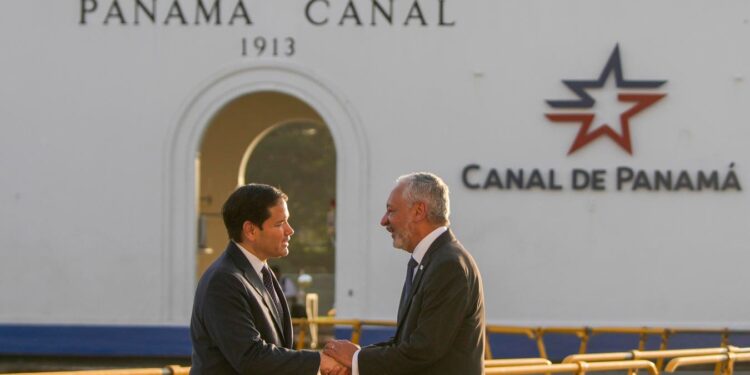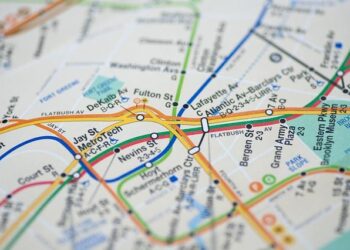U.S. Secretary of State Marco Rubio, left, and Panama Canal Authority Administrator Ricuarte Vásquez … [+] shake hands after touring the Miraflores Locks at the canal in Panama City, Sunday, Feb. 2, 2025. (AP Photo/Mark Schiefelbein, Pool)
Associated Press
The Panama Canal, a 51-mile maritime shortcut linking the Atlantic and Pacific Oceans, is a crucial artery of global trade and a long-standing focal point of international geopolitics. Since its completion by the United States in 1914, the canal has played a critical role in global supply chains by saving container ships weeks of travel around South America. The Panama Canal’s strategic importance has drawn renewed focus from the Trump administration amid concerns over rising tolls and Chinese influence. Why is Panama such a priority for the U.S.?
The heightened interest is part of the Trump administration’s focus on exerting geopolitical control in areas strategic to the United States. Like the reasons behind President Trump’s overtures toward Greenland, the Panama Canal is an asset with an economic and military value that must be secured to protect America. If control of the canal falls into the hands of an adversary, specifically China, it could cause economic damage to the U.S. by disrupting trade and hindering military efforts by restricting passage through the canal. President Trump’s desire to “take back” the Panama Canal is part of a global effort to reduce economic and military vulnerabilities using whatever proactive means necessary.
Immediate U.S. concerns fall into two main categories: rising canal tolls and Chinese control of nearby ports. Before diving into these issues, it is important to understand how control over the canal has shifted over the years.
A Brief History Of The Panama Canal
After a failed attempt to build a canal through Panama by French engineer Ferdinand de Lesseps, the builder of the Suez Canal in Egypt, the U.S. took over construction in 1904. The canal was completed in 1914 under the leadership of President Theodore Roosevelt. For six decades, the U.S. controlled the canal, which became a critical asset for commercial shipping and military strategy. In 1977, under the Torrijos-Carter Treaties, the U.S. agreed to transfer control of the canal to Panama by December 31, 1999, aiming to ease anti-American sentiment and meet Panama’s demands for sovereignty. Since then, Panama has managed the canal through its Panama Canal Authority.
President Trump believes the transfer of ownership to Panama was a mistake. The U.S. paid approximately $375 million to complete canal construction, equivalent to $9 billion today, and Trump feels the U.S. gave up a strategic asset with little in return. The treaties signed by the U.S. and Panama stipulated the canal would remain permanently neutral. Still, the U.S. reserved the right to defend against any threat to the canal’s neutrality using military force under the deal.
Rising Costs For Canal Access
The Panama Canal’s cost has surged, with tolls rising significantly in recent decades. Panama has restructured its toll system multiple times to reflect vessel size, type, and the canal’s growing economic value. In 2002, the Panama Canal changed its pricing from a flat fee based on weight to a system with different rates depending on the type of ship. By 2005-2007, container ships were charged based on how many containers they could carry, making it more expensive for larger vessels. Periodic hikes followed in 2011 and 2016, with tolls rising again after the canal’s 2016 expansion to accommodate much larger container ships. In 2023, Panama introduced a simplified toll structure, reducing categories while raising rates. By 2025, new hikes, such as container ships paying $6 per twenty-foot equivalent unit for empty containers, have raised concerns over excessive cost increases. Canal authorities justified these price hikes as necessary to recover modernization costs and capitalize on the high volume of global trade.
The United States is concerned about rising tolls for several reasons. It is the largest canal user, accounting for approximately 40% of all container traffic. Should toll costs become prohibitive, the U.S. would be at an economic disadvantage. The jump in shipping rates during the COVID-19 pandemic and the subsequent spike in inflation should serve as an example of the importance of shipping costs to the global supply chain.
Growing Chinese Influence
While Panama retains complete canal control, Chinese companies have established a significant presence in nearby port infrastructure. Hutchison Ports PPC, a subsidiary of Hong Kong-based CK Hutchison Holdings, operates two critical terminals at Balboa on the Pacific side and CristĂłbal on the Atlantic side of the canal. These ports, located at either end of the waterway, handle much of the cargo entering and exiting the canal.
Port operators at either end of the Panama Canal are strategically important because they control the flow of goods entering the canal. Their locations at the Atlantic and Pacific entrances allow them to regulate access, manage shipping traffic, and provide fuel, repairs, and storage services. These operators also collect valuable data on global trade patterns and vessel movements, making them significant players in international commerce and geopolitics. Control over these ports can influence supply chain security, trade efficiency, and national security interests.
China’s involvement in Panama is part of its broader multi-billion dollar Belt and Road Initiative, which aims to improve global trade connectivity through infrastructure investments. The BRI was designed to develop new markets for Chinese firms, channel excess industrial capacity overseas, increase access to global resources, and strengthen diplomatic ties with partner countries. It is a series of large projects in which China helps build roads, railways, and ports in other countries to make trade easier and strengthen its connections with the world.
In 2017, Panama became the first Latin American country to join the BRI, opening its doors to Chinese funding for projects such as ports, energy facilities, and even proposals for high-speed rail lines. While these investments have boosted Panama’s ability to increase traffic through the canal, they have also raised concerns about Beijing’s growing influence on such a vital shipping route.
Chinese-operated ports could monitor U.S. naval movements by tracking vessels transiting through or near the canal. The ports could be used to disrupt commerce by delaying or denying U.S. ships access to the canal. In addition, covert Chinese military assets could be stationed at these facilities under civilian cover. While there is no evidence that this is currently taking place, China’s national security laws extend to Hong Kong, and private Hong Kong companies could be forced to follow Chinese directives. A January 28 Senate Commerce Committee meeting validated these concerns by highlighting how Chinese control over key infrastructure near the canal could interfere with U.S. shipping and military assistance to Taiwan in a potential conflict with China.
Secretary of State Marco Rubio Rubio highlighted these concerns at his confirmation hearing. “While technically, sovereignty over the canal has not been turned over to a foreign power, in reality, a foreign power today possesses, through their companies, which we know are not independent, the ability to turn the canal into a choke point in a moment of conflict, and that is a direct threat to the interests and the national security of the United States,” Rubio said.
U.S. infrastructure worries extend beyond Panama. Chinese companies own or operate 129 ports in 66 countries, 14 of which where there is physical potential for naval use. These include major hubs in Europe, Africa, Southeast Asia, and Latin America. These port investments strengthen its export-driven economy and enhance its geopolitical influence, allowing China to shape global shipping routes and negotiate favorable trade terms. The Trump administration aims to reclaim U.S. influence by using its economic power to counter China by forming strategic partnerships or pressuring countries to realign with America.
What’s Next For The Panama Canal?
Looking ahead, Panama faces a delicate balancing act between maintaining economic ties with China and addressing U.S. national security and economic concerns. Panama recently announced it would not renew its Belt and Road Initiative agreement with China, a move seen as an attempt to align more closely with Washington’s interests. According to Bloomberg, Panama President Jose Raul Mulino is considering canceling the contracts held by Hutchison to operate the ports. Panama also promised free passage for U.S. warships following Rubio’s visit on February 2 to appease American interests.
The future of the canal will depend on how Panama navigates these competing pressures from China and the U.S. “Trump seems to be making an example out of Panama with the goal of getting other regional leaders to think twice before they take any bold steps to deepen ties with Beijing,” said Will Freeman, CFR fellow for Latin America Studies. Panama is among the first countries to feel the wrath of the Trump Administration’s aggressive foreign policy. It probably won’t be the last.
Source link : http://www.bing.com/news/apiclick.aspx?ref=FexRss&aid=&tid=67a3b63141d74fd6ab928ae47151e08d&url=https%3A%2F%2Fwww.forbes.com%2Fsites%2Fgarthfriesen%2F2025%2F02%2F05%2Fwhy-the-panama-canal-is-at-the-center-of-a-us-china-power-struggle%2F&c=324580501378952927&mkt=en-us
Author :
Publish date : 2025-02-05 03:25:00
Copyright for syndicated content belongs to the linked Source.












